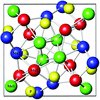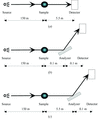issue contents
March 2005 issue

Cover illustration: Orientation maps for substrate (Ni) and oxide film (CeO2) produced by X-ray microdiffraction (see Ice, Larson, Yang, Budai, Tischler, Pang, Barabash and Liu, pages 155-162). Colour indicates the angle and direction of [001] with respect to surface normal (white).
facility information
materials research
Open  access
access
 access
accessAn X-ray nanodiffraction technique has been developed and applied to study the structure of individual tin oxide nanobelts.
Catalysts and Azul Maya are defined as `surface compounds' in which one phase interacts with another at the surface. These surface compounds are studied by several synchrotron techniques and the results presented.
The coupling of new diamond-anvil cell and synchrotron radiation techniques reveals new findings about materials over a broad range of pressures.
Polychromatic microdiffraction allows for submicrometer three-dimensional spatial resolution and good sensitivity to elastic strain, crystalline phase and local texture (orientation). Example applications are presented for this emerging tool.
In situ synchrotron X-ray scattering is used to observe the growth of PbTiO3 films by metal-organic chemical vapour deposition and the behaviour of the ferroelectric phase transition as a function of film thickness.
An overview is given of the prominent aspects of the polarization of the light delivered by bending magnets and some dichroic properties in X-ray absorption spectroscopy. Two studies developed at the Brazilian Synchrotron Light Laboratory are reported, illustrating the profit gained using linear and circular polarization for the study of magnetic thin films and multilayers.
Time-resolved X-ray diffraction is a very powerful tool in the study of structural dynamics of solids. This work demonstrates how it can be used to view transient strains in crystalline solids.
Cu K-edge XAFS on La2CuO4.1 is presented, providing evidence for a non-homogeneous structure on the local atomic scale.
Intense synchrotron X-rays are used to image high-transient high-pressure high-speed fuel sprays in a time-resolved and quantitative manner.
research papers
ID22: a multitechnique hard X-ray microprobe beamline at the European Synchrotron Radiation Facility
The ID22 beamline is dedicated to hard X-ray microanalysis allowing the combination of fluorescence, spectroscopy, diffraction and tomography techniques in a wide energy range from 6 to 70 keV. A review of the recent developments of the beamline and a detailed description of its capabilities through examples from different fields of applications are presented.
Temperature-dependent X-ray absorption spectroscopy is employed for the investigation of organic PbBr2 solutions in a new in situ cell in the temperature range from room temperature to ∼450 K.
Open  access
access
 access
accessA procedure for correcting for the effects of specimen charging on X-ray absorption near-edge structure (XANES) recorded by total electron yield is discussed. The corrected XANES is compared with the electron energy-loss near-edge structure from the same materials and several sources of artefacts are discussed.
The ordering of Fe and Ni inside meteoritic (Fe,Ni)3P crystals has been determined using anomalous dispersion (δ-technique).
Experimental evidence of the possible combination of `propagation-based' and `analyzer-based' phase-contrast imaging.
teaching and education
Free 

A new internet-based synchrotron experiment for students is presented for measuring the X-ray magnetic circular dichroism of PtFe around its Pt LII and LIII absorption edges via the internet.
short communications
A new method is proposed for the imaging of the flux-line lattice of a type-II superconductor by soft X-ray absorption microscopy. It is shown that the method is very demanding but probably realisable in the foreseeable future.
current events
Free 



 journal menu
journal menu










































